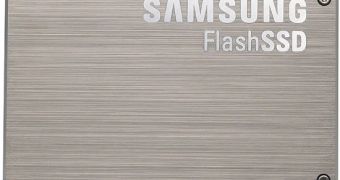Samsung announced yesterday that it had developed a 100GB solid-state drive, specifically designed to meet the storage and performance requirements of server computer systems that are meant to deliver video on demand, stream media content, or provide online transaction processing. The new SSD, dubbed SS805, has been announced at the Storage Vision 2009 Conference in Las Vegas, where the company claimed it to be an alternative to traditional hard-disk drives that boast a platter operating speed of 15,000 revolutions.
“We have created a very reliable drive for data centers with high-performance, high-endurance and sharply reduced power consumption requirements, plus tremendous long-term value when the total cost of ownership is analyzed,” said Jim Elliott, vice president, memory marketing, Samsung Semiconductor, Inc. “Our new enterprise SSD offers CIOs and IT managers the ability to greatly improve storage reliability and capacity while avoiding costly power and AC infrastructure upgrades in data centers at or near capacity,” he added.
According to the company, its new Flash-based SSD is capable of providing as much as 100 times the number of input/output per second per watt as a 2.5-inch, 15.000RPM hard drive. This enables the SS805 to provide an excellent solution for working environments where higher performance is needed, but not at the cost of power consumption.
The SSD, which boasts an SAS interface, is claimed to read data sequentially at a speed of 230MB per second, while the sequential read speed is rated at 180MB/s. This high level of performance is achieved thanks to the implementation of a sophisticated eight-channel controller, and better NAND flash and firmware, when compared to the previous generation of SSDs. Samsung's SS805 uses just 1.9 watts of power in active mode and 0.6 watts when idle, compared to the 8 to 15 watts of power in active mode and 2 watts when idle, for traditional 15.000 hard-disk drives.
The company said that the new drives were expected to become available this quarter, but pricing details are yet to be made available.

 14 DAY TRIAL //
14 DAY TRIAL //